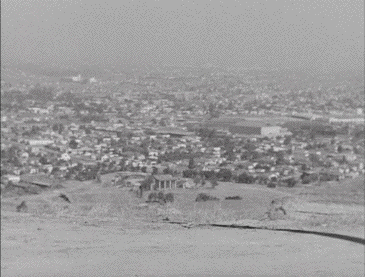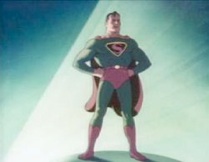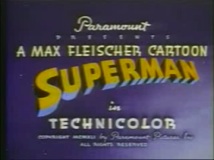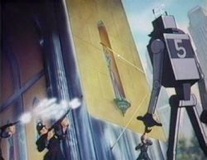Flying Scenes
animations created by Richard Potter
As a kid, I was fascinated by the flying scenes in the Adventures of Superman. How I wished that I, too, could leap into the sky and fly! I was thrilled every time George hurled himself out of the window of the Daily Planet storeroom. For me, the sense of majesty and freedom that it conveyed was almost spiritual.
Of course, the special effects in the Adventures of Superman are not as dazzling as some of the CGI wizardry we see in today’s movies and TV. But they were spectacular in the context of the 1950’s. When you compare what was accomplished in seasons 1 and 2 of the series with what was done in other science fiction films and TV at the time, they really are outstanding. The flying sequences in particular shine to this day as an amazing achievement. And one has to acknowledge that part of the reason why they were so impressive is due to George -- who made flying seem very real. It is a credit to his acting ability that when he’s up on wires, he looks very natural and makes it completely believable that a man can fly.
Without question, for those of us who are “flight enthusiasts,” the two most important episodes in the entire series are (1) Shot in the Dark and (2) Panic in the Sky.
Panic in the Sky: Superman has a date with destiny -- the dramatic takeoff in his first (and unsuccessful) attempt to save the world.
Shot in the Dark: Flying across Metropolis, on a mission to avert a subway disaster.
Shot in the Dark is significant because it contains the longest sustained, uninterrupted scene of Superman flying in any episode. The “stock” footage of Superman in flight (which was used over and over throughout the series) is shot from a distance and shows Superman in horizontal profile. It is fairly static: for the most part, George’s body remains stationary; usually, the only things that move are his cape and the scenery in the background that zooms past (although sometimes we see his arms move slightly and his head turn to the side). By contrast, the Shot in the Dark footage is shot close-up and in three-quarters profile. In addition, it is extremely dynamic: it shows his entire body banking and rolling -- with his head, arms and legs all in motion.
One thing that has always puzzled me about the Adventures of Superman is why they didn’t re-use this footage in very many other episodes. Strictly speaking, brief excerpts were re-used in The Machine That Could Plot Crimes and Star of Fate (thanks to David Orbach for reminding me about these two episodes). In addition, a brief segment was used in Stamp Day for Superman, which was a special episode, rarely seen, and not broadcast as part of the original series. But most episodes just replayed the stock footage over and over. I understand that they were operating with a tight budget which dictated that they had to recycle film, but why, oh why, didn’t they re-use the Shot in the Dark footage? It’s so much more interesting and exciting! Of course nowadays, thanks to the miracle of DVD, as you watch this flying scene you can clearly see the wires that are holding George up. Indeed, sometimes you can see that his cape actually gets caught in the wires! Perhaps it was the fact that the wires were so visible and/or the fact that the cape gets visibly tangled in the wires that made the producers decide to re-use this footage sparingly.
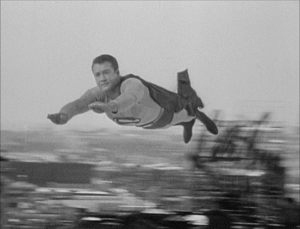
The Machine That Could Plot Crimes uses only the very beginning of the flight sequence (George takes off, blinks, looks to the side) -- and then cuts before the cape begins to get tangled. Ironically, the only segment that Star of Fate uses is the part in which George’s cape is noticeably tangled in the wires! (See the frame above.)
Panic in the Sky is one of the best episodes of the entire series. (Indeed, many would argue that it is the best episode.) And it is important to us flying aficionados for several reasons. Like Shot in the Dark, Panic has unique flying footage that was never used again in any subsequent episode. In addition, it devotes more “air time” (pun definitely intended) to flying scenes than any other episode. Last but not least, this episode has a spectacular variety of flying scenes, many of which were rarely used again: (a) as Superman leaves Earth for his rendezvous with the asteroid in outer space, we see him flying straight towards us, with Metropolis below; (b) as Superman approaches the asteroid right before impact, we see him from behind as he flies away from us; and (c) after the second (and thank goodness, successful) attempt to destroy the asteroid, we see Superman from above, with the city below, as he zooms back down to Earth.
It is understandable why most of the flying scenes that were shot for this episode were never re-used. That is because in many of them, George is flying into outer space and/or carrying a bomb. However much the producers may have wished that they could stretch those special effects dollars, they understandably realized that it would be difficult to re-use this footage. After all, if Superman were to take off from the Daily Planet storeroom to save Lois and Jimmy but then in the very next scene, he was flying into outer space with a bomb under his arm, the viewer might notice that something was not quite right! Of course, this kind of inconsistency in scene continuity did not seem to faze the producers when it came to re-using stock footage of George heading to the storeroom of the Daily Planet to change into Superman. In many episodes, George leaves Perry’s office or his own office without a hat in hand or on his head, but by the time he reaches the door to the storeroom, he’s wearing his chapeau. And sometimes just the reverse happens -- as he is leaving his office, he grabs his hat but by the time he reaches the storeroom, the hat has disappeared.
Panic in the Sky: On a collision course with the asteroid.
Panic in the Sky: Impact!!!! (I modified the last few frames to replace the cartoon explosion in the original episode.)
Here’s an interesting fact: David Orbach has pointed out that the cartoon animation used in Panic in the Sky (which I replaced in the animation above with a slightly more realistic sequence) actually came from the 1941 Max Fleischer Superman (aka The Mad Scientist) cartoon. You can see for yourself by comparing the two frames below:
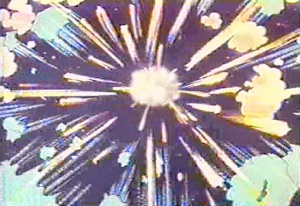
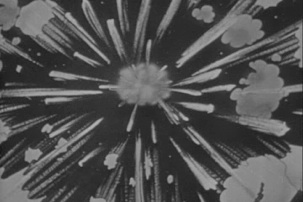
From Max Fleischer’s 1941 Superman cartoon.
From Panic in the Sky.
I highly recommend the Fleischer Superman cartoons. They are regarded as classics of animation and are a whole lot of fun! According to urban legend, it was in these cartoons that Superman actually began to fly for the first time. In the comics, he would merely leap great distances. But the animators discovered that when they animated him jumping around, he looked too much like a grasshopper or something. They argued that it would look much better if he seemed to be flying and voila -- the rest is history.
Spoken by a child being held in Superman’s arms, this is without a doubt the most profound line of dialog in the entire series. It clearly illustrates that the Adventures of Superman not only went far beyond being a mere “kiddie show” but did in fact, at least in this one instance, achieve the sublime.
The brilliant screenplay for Around the World with Superman was written by Jackson Gillis, who wrote several other screenplays for the show, including Panic in the Sky.
“Oh, Superman, I wonder if people know how beautiful the world really is.”
Every child’s dream come true: flying through the air with Superman.
Around the World with Superman
I like the way Ann (Judy Anne Nugent) swings her feet and looks back. Those were nice touches. And of course, George made it all seem so very real. Around the World with Superman.
Flying over London. Very few moments in the entire history of television and motion pictures are as magical and touching as the sequence of flying scenes in which Superman carries Ann around the world in his arms.
Rare perspective on Superman in flight from The Man in the Lead Mask. (Also used in The Boy Who Hated Superman.)
A flight maneuver very rarely seen: Superman flies over Metropolis and then uprights himself in preparation to land in The Defeat of Superman.
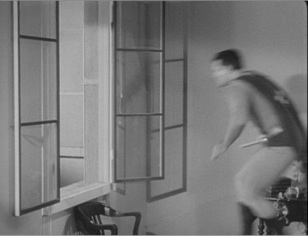
Classic storeroom take-off scene from The Birthday Letter. Here’s an amusing bit of trivia: Although the storeroom take-off scene was used repeatedly in the black & white episodes, it was originally shot for The Human Bomb. In that episode, Superman flies a stick of dynamite out of the Daily Planet and detonates it high up in the air over Metropolis in order to test whether the threat posed by "Bet A Million" Butler (aka The Human Bomb) is real. The scene goes by very fast, making it difficult to see the stick of dynamite in George’s right hand. But it is there, as the still frame on the right clearly indicates. I guess the producers said to themselves, “Hey, if the viewers aren’t bothered by the on-again, off-again hat, what’s a little stick of dynamite between friends? No-one will ever notice.”
“I’d better go!” A very rare take-off scene in which George himself, rather than a stunt double, is lifted off the ground using wires. First used in the 1951 theatrical release, Superman and the Mole Men and later in the series itself, in The Unknown People, Part 1.
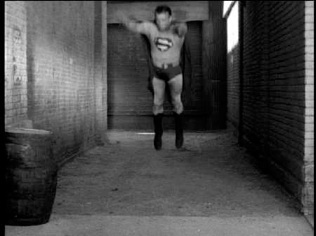
Classic alley take-off, segments of which were used in several episodes. This particular version is from The Talkative Dummy with the last few frames (in which the trash blows into the alley) derived from The Unknown People, Part 1. This is an unusual version, because we see Clark turn around momentarily and remove his glasses (almost as if they were goggles). In most other versions, we simply see Clark remove his hat as he runs into the rear of the alley with his back to the camera the entire time. Or. as in The Defeat of Superman, we see him turn around briefly without removing his glasses. Note the stunt double as Superman leaves the ground (captured in the frame on the right).
Take-off sequence from Shot in the Dark. Notice the expression on George’s face as he prepares to hit the springboard in order to launch himself over the camera (captured in the frame on the right). Look closely at the bottom of the animation and you can see the springboard pop into frame after lift-off. Thanks to David Orbach for pointing out that this take-off scene was originally used in The Riddle of the Chinese Jade from the first season of the show and resurfaced for a third and final time in the second season in one of Jack Larson’s all-time favorite episodes, Semi-Private Eye.

Flying over Metropolis with Kathy (Isa Ashdown) in The Birthday Letter. I don’t care what anybody says, it’s the only way to fly!
It seems pretty clear that the two flying sequences below were actually shot in one session at the same time, but then split apart and used in two different episodes. To my knowledge, there is no episode in which the two sequences are combined into one continuous scene.
Part 1: Flying over the city, on a mission to save Lois and Jimmy from the crafty Dr. Ort (portrayed by Peter Brocco) in The Secret of Superman. The scene runs as follows. It begins with Superman looking over his left shoulder; then he looks straight ahead, and then he looks to his right. The scene cuts at that point in this episode.
Part 2: Flying over the city, on his way to pay Kathy Williams a visit in The Birthday Letter. The scene begins almost exactly where the one from The Secret of Superman ends -- with Superman looking to his right. George’s position relative to the buildings below is a perfect match to the final frame in The Secret of Superman footage.
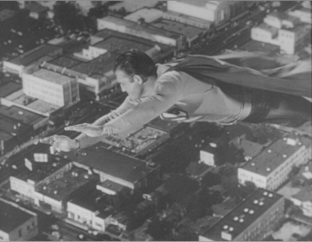
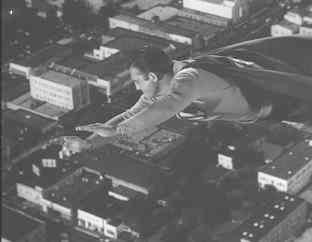
The last frame of Part 1 from The Secret of Superman.
The first frame of Part 2 from The Birthday Letter. Almost a perfect match to the last frame of Part 1.
Parts 1 and 2 combined.
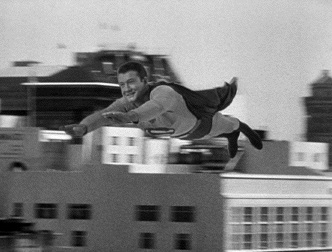
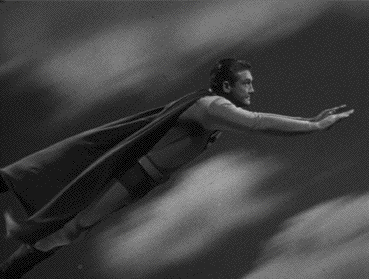
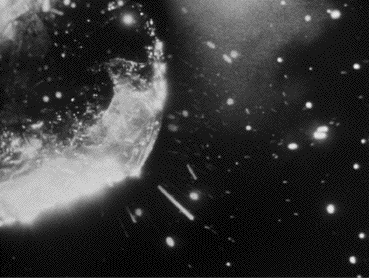

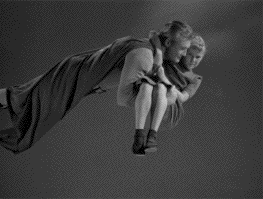

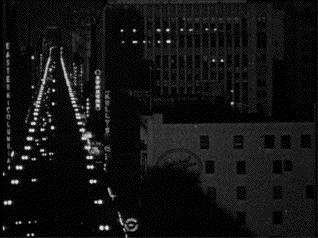
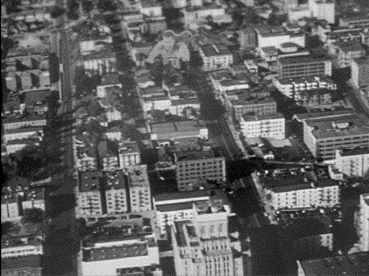

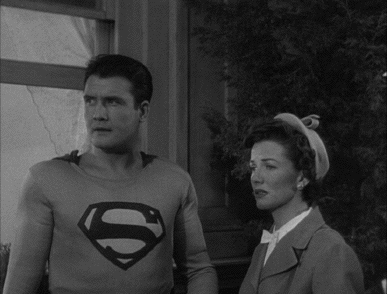
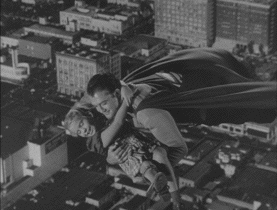
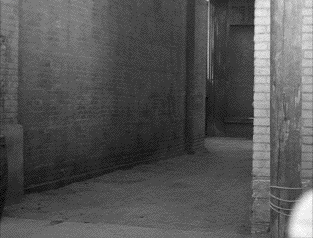


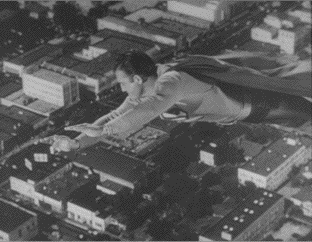
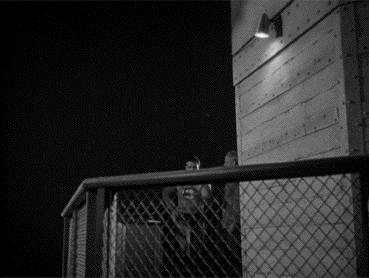
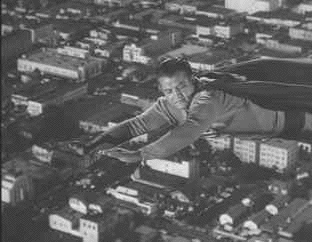
Before
After
A take-off scene from The Mind Machine. Two things have always bothered me about this take-off. First of all, even as a kid it was pretty obvious to me, watching this episode on my family’s grainy, old black and white TV, that it was a stunt double, not George, being lifted off the ground.
The second problem with this take-off is that the angle of ascent is all wrong. Instead of appearing to fly up and out of frame, Superman seems to be sort of “swung” sideways out of frame. You can even see right before the stunt man goes completely out of frame that his body is starting to get more upright. Of course, I can’t really fault the special effects guys for this failure to achieve total realism. After all, they’re out there in the countryside, not inside a studio, and yet somehow they have to achieve the effect of Superman flying up off the ground with wires and a crane. So that would have been a huge technical challenge and I have to give them tremendous credit for what they accomplished.
In my “revised” version, I’ve attempted to fix the problem and make the take-off truly “up, up and away.”
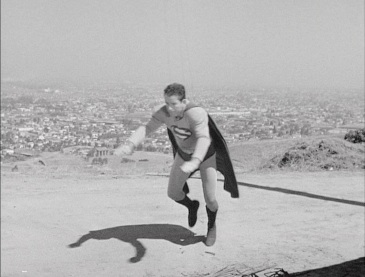
Carey Loftin is the stunt double being lifted off the ground in The Mind Machine. I have to give Mr. Loftin (and all the stunt men, including Dale Van Sickel and George himself) a lot of credit. It took guts to do this kind of stunt. There was always the chance that the wires would snap, as George discovered. (Unfortunately, the IMDb fails to list the Adventures of Superman in Mr. Loftin’s screen credits.)
A Revised Take-Off Scene
Taking off to save the children on a runaway bus
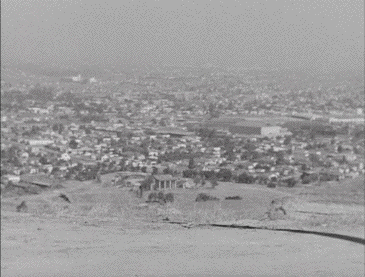
A Restored Flying Scene
Flying over Metropolis
